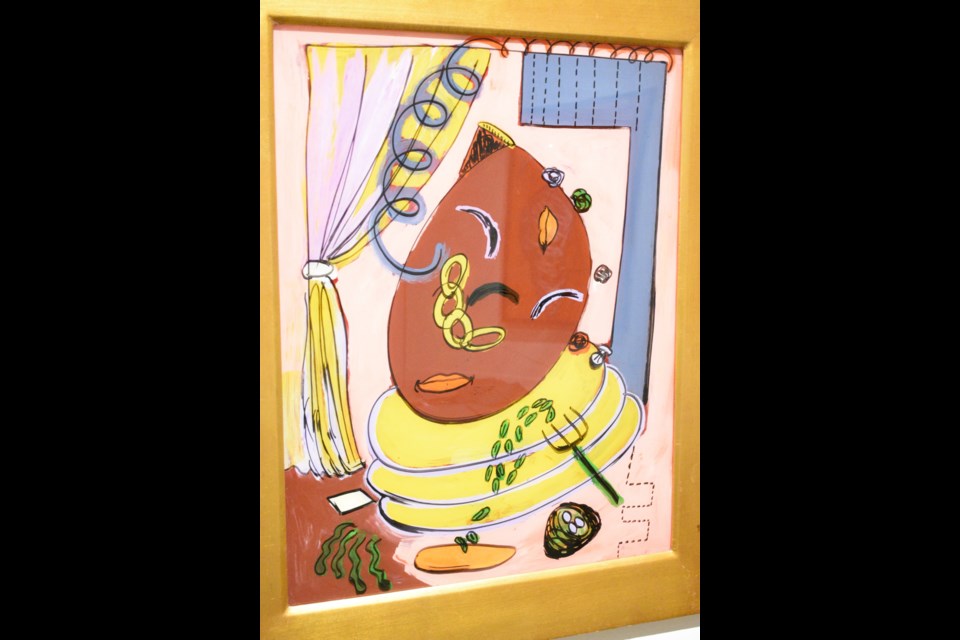MOOSE JAW — Searching through over 600 artworks by renowned feminist artist Leesa Streifler to find the best to showcase was not easy for curators Jennifer McRorie and Wayne Baerwaldt, but their connections to her made the job easier.
The 109 mixed-media artworks that McRorie and Baerwaldt eventually chose form the basis for the Moose Jaw Museum and Art Gallery’s (MJMAG) latest exhibition, “Lessa Streifler: The Performance of Being,” which runs from Sept. 27 to Sunday, Dec. 8.
The two co-curators spoke to MooseJawToday.com about their efforts to create the display.
“I’m thrilled with how it’s come together. And just the amount of colour that’s in here and the energy from these images,” said McRorie, the MJMAG’s main curator. “And the way our space is, it kind of gets broken down into different rooms, so they almost seem like (different) shows put together.”
Laughing, McRorie said they jumped through many hoops before the National Gallery of Canada sent some pieces, while the co-curators were excited when a semi-trailer rolled in after collecting artworks from six other provincial or national galleries.
Streifler was McRorie’s fine arts professor in the 1990s at the University of Regina, so the latter was familiar with some of the former’s work from that decade.
During a tour of the Norma Lang Gallery, the curator pointed to several artworks that she saw from exhibitions in 1992, 1996 and 2012. She noted that she facilitated conversations about artwork from the second exhibition and wrote an explainer for the third show.
“So I know that work intimately from back then. So that’s (also) kind of like seeing old friends too,” McRorie said, noting she couldn’t pick a favourite piece because they all spoke to her differently.
Streifler’s work is based on her experiences, feminist points of view and feminist theory, while it reflects her relationships with her parents, siblings, husband and son, along with concepts about body image and identity, she continued. Those ideas have been consistent during the past 41 years, whether the artwork is from 1987 or 2021.
“Going through all the work we did and having to choose what would make sense (and) what would build the narrative of her career, that was a real task,” McRorie added. “And (it was) hard to let go of some pieces too. There’s so much to choose from.”
McRorie asked Baerwaldt to help curate Streifler’s exhibition because he met her in the late 1980s at the U of R. Moreover, he had been a curator in Winnipeg, where Streifler grew up and had a studio.
She returned to Winnipeg after retiring in 2019, reopened her studio and began producing more works. Baerwaldt visited her recently, making him familiar with her newest works.
“It just kind of became obvious that all of the early work and all these early theoretical underpinnings of the work were still apparent in the current work. And this sort of strong feminist position was still there,” he said, noting the artworks’ themes all overlapped, making it difficult to divide them into the four categories for the show.
“And in (this) Trumpian era, where women’s rights are in question these days, it all became apparent that her work … was super relevant again and should be examined for what it was in the ’80s compared to now in 2024,” Baerwaldt continued.
While he didn’t have a favourite piece, Baerwaldt was intrigued with Streifler’s sketchbooks, which show the human body from a feminist perspective. Some sketchbooks are also autobiographical, while others look like journal entries with handwritten notes or scribbles — but more than random scribbles, they have meaning and resonance.
“(The) ordinary viewer might not take so much away from this sort of abstract, figurative, nonsensical work,” he said. “Of course, nonsense has meaning in the art world.”
An interesting discovery McRorie made was seeing the iconography in Streifler’s works that featured similar images, such as chains to represent cause and effect, nests with eggs to represent family and spirals to represent energy.
The MJMAG curator added that she and Baerwaldt developed the exhibition’s title after realizing some artworks focused on the theme of performance and performing identity, ideas they thought would resonate well with audiences, especially youths.




